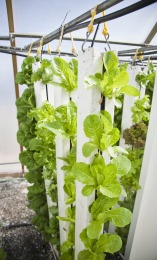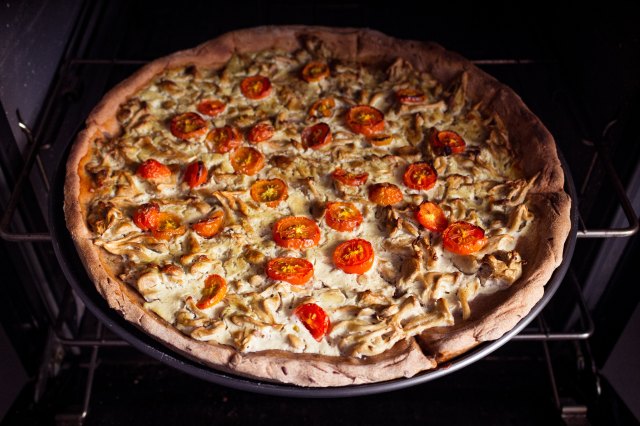Do you think you’d enjoy a steak more if you knew it was produced in a lab rather than coming from a cow? How about with a side of vegetables grown in your own kitchen? Or maybe you’d rather just call out for pizza. Would it taste better if it was made on the truck while it was on the way to your house?
These are just of few of the things mentioned at this week’s Techonomy NYC session on technology and the future of food. Zoe Leavitt, an analyst with CB Insights, framed the discussion by noting that while we need more food to feed what is a growing global population, 40% of the food grown and harvested in the U.S. gets thrown out. To address this and the growing challenge of climate change Leavitt said we need to look at creating new products, utilizing new agricultural strategies and being smarter about how food is distributed.
All of the things mentioned above are more than just ideas, there are startups working to make each of these a reality. And there were some even wilder ideas discussed. Like having a 3D printer in your home that gathers data from all the sensors in places like your refrigerator and your bathroom and then prints a personalized dietary supplement.
Here are some of the startup technology companies that are bidding to influence the future of food:
 This company is up and running, operating vertical, indoor farms. They are headquartered in Newark, N.J., where they have occupied an old steel mill and converted it to a farm that harvests up to 2 million pounds of produce a year. David Rosenberg, CEO, was at the Techonomy conference. He noted that the “Dream Greens” produced in Newark use 95% less water, zero pesticides and produce fresh food 365 days a year. Their growing cycle is much faster than traditional farms allowing them to be more productive as well as providing the obvious benefit of cutting down on land usage.
This company is up and running, operating vertical, indoor farms. They are headquartered in Newark, N.J., where they have occupied an old steel mill and converted it to a farm that harvests up to 2 million pounds of produce a year. David Rosenberg, CEO, was at the Techonomy conference. He noted that the “Dream Greens” produced in Newark use 95% less water, zero pesticides and produce fresh food 365 days a year. Their growing cycle is much faster than traditional farms allowing them to be more productive as well as providing the obvious benefit of cutting down on land usage.
Grove Labs
Grove Labs is a five-year old company that focuses on what it calls hyper-local agriculture, like grown in your house. They have built an ecosystem that allows you to grow your own food in your kitchen, what CEO Gabe Blanchett called the “living kitchen.” He also suggested that this type of indoor agriculture could be used by restaurants or schools. A look at Grove’s Facebook posts show homegrown cherry tomatoes, greens, chard and all kinds of flowers. While Grove has marketed its own hydroponic farming systems it also produces pods to be used with devices produced by appliance and furniture manufacturers.
Memphis Meats
This is the company that is working on producing meat that doesn’t involve killing any animals They are doing this by producing meat directly from animal cells. On their web site they claim to have made beef, chicken and duck. They have also produced a lab grown meatball, although the cost at this stage is prohibitive. Bill Gates and Richard Branson are among Memphis Meats’ investors. Their goal: meat that is “good for people, animals and the planet.”
Bond Pet Foods
Here’s another company that is in the business of creating lab produced meat. They say “we don’t think one animal needs to be harmed to feed another.” They use animal proteins in a process that they compare to craft brewing. The benefits: conserves land, water and energy; no animal needs be slaughtered; and pets get cleaner, heathier food.
Finless Foods
Same goes for fish. This is the ultimate sustainable seafood since no fish ever has to get pulled out of the ocean. Like the lab meat makers this involves the use of cells. The cells are incubated into tissue and “harvested.” In addition to saving the fish in the ocean, this method promises to control mercury content and avoids some of the contaminants that have been associated with fish farms. They are not yet ready to produce filets, their first public tasting involved “carp croquettes.”
Zume Pizza
Robot-made pizza. They guys are up and running in Mountain View, Calif. You can go to their web site and use their app and order a pizza, at least if you’re in Silicon Valley you can. By making the pizzas with machines rather than humans, Zume can produce 370 pizzas an hour at their plant. The fast production means delivery takes 5-20 minutes. There is still a bit of human involvement, like sprinking toppings on the pizza and placing the finished product into the automatic slicers. But most of the work is done by robots like Marta the sauce spreader and Vincenzo, the bag of nuts and bolts that puts it in the oven.

Image: Ronaldo de Oliveira

I’m a semi-vegeterian, and I find this post great.
LikeLiked by 1 person
Well, while I can totally get behind the garden in your kitchen concept, the animals from a lab are somewhat terrifying! At least the greens are natural, but the animals? Hmmm. Then what happens to the real ones who will still need to do eat and drink? Do we have an overpopulation problem them. While man has been harnessing nature since the beginning, I’m always nervous when they start getting too far afield in the biology department. I try to steer clear of GMO foods, but with the burgeoning population and the advances in science, in a hundred years, everything could be a GMO food. Thanks for this enlightening post, Ken.
LikeLiked by 2 people
I try to avoid GMO food as well. But if you think of technology as a way to produce more while conserving natural resources like land and water, it seems like a good thing. I’d be happy to eat the greens growing in the vertical farm in Newark. On the other hand, when technology is used to lower the cost for large producers and enhance their profits, it usually doesn’t translate into better food.
LikeLiked by 3 people
Totally agree. I want to grow food in my kitchen!
LikeLiked by 1 person
It will be interesting to see what happens with this industry. I’m not so sure about the cloned meat, but the living kitchen sounds great.
LikeLiked by 2 people
Wow! It is scary to know that food may be fully lab created. Isn’t it going to cause some side effects?
LikeLiked by 1 person
Who knows? Pretty sure there will be some mishaps along the way, although things like a vertical garden or a robot-made pizza sound like safer bets than lab produced fish.
LikeLiked by 1 person
Yes definitely! I wonder if they will be as nutritious as those grown on a soil.
LikeLike
It all sounds a little like science fiction (especially the meat grown from cells in labs), but so did horseless carriages and flying machines– not so long ago—in my grandparents’ lifetimes. This post is encouraging me to try some small scale vegetable growing on our back deck this summer. The US is so far behind Europe when it comes to GMO regulation. I remember seeing the GMO disclosures on food for the first time during a 1999 visit to England.
LikeLiked by 2 people
The mention of a lab-grown meatball made me chuckle. I don’t eat any red meat at home anywhere, but every now and again, I’ll get a steak when I’m out to dinner. If it were grown in a lab, it would certainly mess with my head the first few times, but if it tasted decent, I suppose I’d get used to it. The same goes for fish. I’ve been reading about Tilapia lately and the horrible conditions they are raised on. I’ve learned so much about food in the past year and a half that it makes my head swim at times.
LikeLike
Interesting
LikeLike
I’m waiting for the meat made from fungus.
LikeLike
I might pass on that.
LikeLike
I like the idea of hydroponic veggies, less chance of dirt (e-coli) in them. My daughter sells those Tower Gardens for Juice Plus company. I have seen them in malls and outside restaurants. . . So interesting and glad to learn about the fish! Thank you! Smiles, Robin 🌞
LikeLiked by 1 person
Good one!
LikeLiked by 1 person